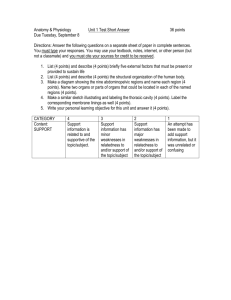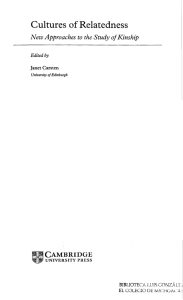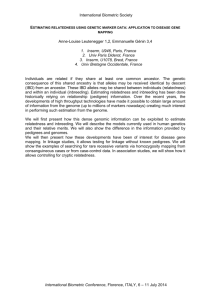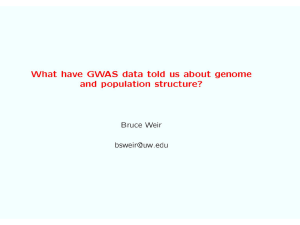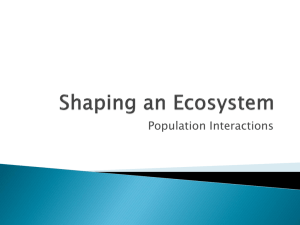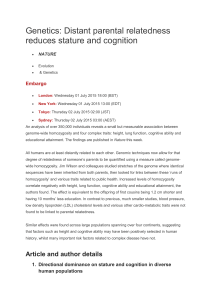Relatedness and spatial proximity as determinants of
advertisement
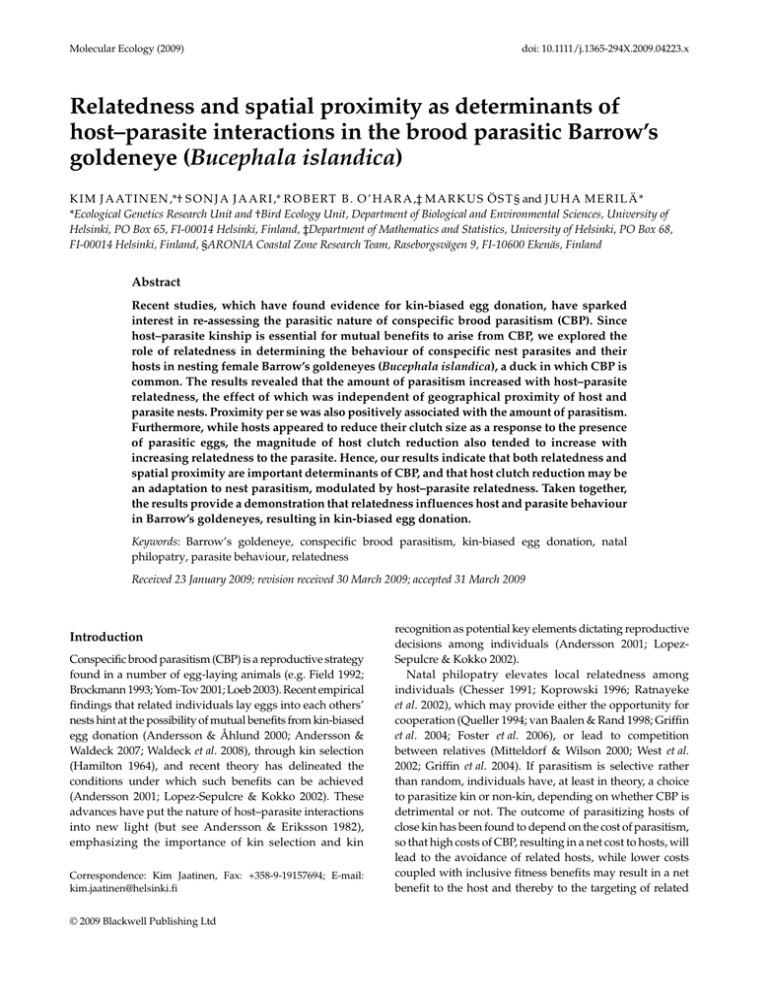
Molecular Ecology (2009)
doi: 10.1111/j.1365-294X.2009.04223.x
Relatedness and spatial proximity as determinants of
host–parasite interactions in the brood parasitic Barrow’s
goldeneye (Bucephala islandica)
Blackwell Publishing Ltd
K I M J A AT I N E N ,*† S O N J A J A A R I ,* R O B E RT B . O ’ H A R A ,‡ M A R K U S Ö S T § and J U H A M E R I L Ä *
*Ecological Genetics Research Unit and †Bird Ecology Unit, Department of Biological and Environmental Sciences, University of
Helsinki, PO Box 65, FI-00014 Helsinki, Finland, ‡Department of Mathematics and Statistics, University of Helsinki, PO Box 68,
FI-00014 Helsinki, Finland, §ARONIA Coastal Zone Research Team, Raseborgsvägen 9, FI-10600 Ekenäs, Finland
Abstract
Recent studies, which have found evidence for kin-biased egg donation, have sparked
interest in re-assessing the parasitic nature of conspecific brood parasitism (CBP). Since
host–parasite kinship is essential for mutual benefits to arise from CBP, we explored the
role of relatedness in determining the behaviour of conspecific nest parasites and their
hosts in nesting female Barrow’s goldeneyes (Bucephala islandica), a duck in which CBP is
common. The results revealed that the amount of parasitism increased with host–parasite
relatedness, the effect of which was independent of geographical proximity of host and
parasite nests. Proximity per se was also positively associated with the amount of parasitism.
Furthermore, while hosts appeared to reduce their clutch size as a response to the presence
of parasitic eggs, the magnitude of host clutch reduction also tended to increase with
increasing relatedness to the parasite. Hence, our results indicate that both relatedness and
spatial proximity are important determinants of CBP, and that host clutch reduction may be
an adaptation to nest parasitism, modulated by host–parasite relatedness. Taken together,
the results provide a demonstration that relatedness influences host and parasite behaviour
in Barrow’s goldeneyes, resulting in kin-biased egg donation.
Keywords: Barrow’s goldeneye, conspecific brood parasitism, kin-biased egg donation, natal
philopatry, parasite behaviour, relatedness
Received 23 January 2009; revision received 30 March 2009; accepted 31 March 2009
Introduction
Conspecific brood parasitism (CBP) is a reproductive strategy
found in a number of egg-laying animals (e.g. Field 1992;
Brockmann 1993; Yom-Tov 2001; Loeb 2003). Recent empirical
findings that related individuals lay eggs into each others’
nests hint at the possibility of mutual benefits from kin-biased
egg donation (Andersson & Åhlund 2000; Andersson &
Waldeck 2007; Waldeck et al. 2008), through kin selection
(Hamilton 1964), and recent theory has delineated the
conditions under which such benefits can be achieved
(Andersson 2001; Lopez-Sepulcre & Kokko 2002). These
advances have put the nature of host–parasite interactions
into new light (but see Andersson & Eriksson 1982),
emphasizing the importance of kin selection and kin
Correspondence: Kim Jaatinen, Fax: +358-9-19157694; E-mail:
kim.jaatinen@helsinki.fi
© 2009 Blackwell Publishing Ltd
recognition as potential key elements dictating reproductive
decisions among individuals (Andersson 2001; LopezSepulcre & Kokko 2002).
Natal philopatry elevates local relatedness among
individuals (Chesser 1991; Koprowski 1996; Ratnayeke
et al. 2002), which may provide either the opportunity for
cooperation (Queller 1994; van Baalen & Rand 1998; Griffin
et al. 2004; Foster et al. 2006), or lead to competition
between relatives (Mitteldorf & Wilson 2000; West et al.
2002; Griffin et al. 2004). If parasitism is selective rather
than random, individuals have, at least in theory, a choice
to parasitize kin or non-kin, depending on whether CBP is
detrimental or not. The outcome of parasitizing hosts of
close kin has been found to depend on the cost of parasitism,
so that high costs of CBP, resulting in a net cost to hosts, will
lead to the avoidance of related hosts, while lower costs
coupled with inclusive fitness benefits may result in a net
benefit to the host and thereby to the targeting of related
2 K . J A AT I N E N E T A L .
hosts (Zink 2000; Andersson 2001; Lopez-Sepulcre &
Kokko 2002).
The mechanisms leading to potential kin-biased egg
donation are still unknown (for discussion about potential
mechanisms, see Andersson 2001; Semel & Sherman 2001;
Lopez-Sepulcre & Kokko 2002; Pöysä 2004; Andersson &
Waldeck 2007). Natal philopatry has been viewed as a null
hypothesis, because it results in elevated local relatedness
which, coupled with parasite preference for nearby hosts,
may lead to kin-biased egg donation. This null hypothesis
has, however, been refuted by recent empirical evidence
which suggests that some mechanism of kin recognition is
involved in kin-biased egg donation (Andersson & Åhlund
2000; Andersson & Waldeck 2007; Waldeck et al. 2008).
Seen from an inclusive fitness perspective, the overall
effect of CBP on host fitness may not be negative and an
alternative explanation based on cooperation has been
proposed (Andersson & Åhlund 2000; Lopez-Sepulcre &
Kokko 2002). Lopez-Sepulcre & Kokko (2002) underlined
the need for some level of kin recognition, albeit imperfect,
to be present if parasitizing relatives is to be beneficial.
The roles of donors in studies of the role of relatedness in
CBP have yet to be identified (e.g. Andersson & Waldeck
2007; Waldeck et al. 2008; but see Roy Nielsen et al. 2006).
This may confuse any inferences about decision-making as
the breeding status of the parasite is not known and these
individuals may or may not have a nest site of their own.
Three roles can be identified for breeding individuals within
CBP systems: (i) nonparasites (‘conventional’ breeding),
(ii) true parasites, and (iii) nesting parasites (Åhlund &
Andersson 2001; Lyon & Eadie 2008). True parasites
reproduce solely by donating eggs. Nesting parasites may
prefer to donate eggs close to their own nest because they
have better information about nest locations, or there may
be constraints on time or travel distance. Thus, all other
things being equal, nesting parasites are likely to prefer
close nests over more distant ones even if the costs of travel
will be greatly outweighed by the benefits of parasitizing.
Such distance-constrained egg donation behaviour
coupled with the presence of natal philopatry might
lead to elevated host–parasite relatedness without requiring kin discrimination. However, if parasitizing is selective
and relatedness plays a role in decision-making, or if both
distance and relatedness are of importance, relatedness between interactants may not be driven by natal
philopatry alone.
The aim of this study was to examine the role of relatedness in determining the behaviour of conspecific brood
parasites and their hosts. We did this by genotyping 32
breeding females and 288 ducklings at 19 microsatellite
loci from a Canadian population of the brood-parasitic
Barrow’s goldeneye (Bucephala islandica). Assignment of
maternity to parasitic young in host nests allowed us to
study the spatial genetic structure of brood parasitism, and
most importantly, disentangle the effects of spatial proximity
and relatedness on host–parasite interactions. We also
investigated host responses to parasitism by analyzing the
number of parasitic eggs in relation to the host’s own clutch
size and host–parasite relatedness, thereby shedding light
on the possible presence of mechanisms leading to kinbiased egg donation in the CBP system of waterfowl, in
which CBP is especially common (Yom-Tov 2001). By utilizing
high-resolution genotypic data, we were able to study the
behaviour of individuals of known roles in a CBP network,
thereby gaining novel insights into the reproductive
decision-making by both hosts and parasites.
Methods
Study area and population
The study was conducted at Riske Creek, close to the town
of Williams Lake (51°52′N, 122°21′W), British Columbia,
Canada, in 2006. The study area consists of a prairie
plateau approximately 200 km2 in size interspersed with a
large number of ponds and lakes, with trembling aspen
(Populus tremuloides) stands along the shores. The plateau is
surrounded by mixed coniferous forest consisting mainly of
lodgepole pine (Pinus contorta) and Douglas-fir (Pseudotsuga
menziezii). Nest boxes were erected in the aspen and
coniferous stands in 2004, as close to the shorelines of the
wetlands as possible, resulting in a total of 127 nest boxes
being placed around 36 ponds and lakes. The coordinates
of all nest boxes were recorded using a global positioning
system (GPS) unit. Seventy nests were initiated in 2006,
half of which (35) hatched successfully.
Sampling and laboratory methods
During the 2006 breeding season, 32 females were caught
by hand or by hand net from the nest aperture for banding,
taking structural measurements (viz. weight, lengths of
wing chord, culmen, radius-ulna and tarsus) and DNA
sampling. To estimate the date of incubation onset, we
used the egg flotation method of Kilpi & Lindström (1997),
modified to Barrow’s goldeneyes with an incubation period
of approximately 32 days. The method provides a reliable
estimate of the number of days the eggs have been incubated
and hence allows the estimation of brood hatch date. DNA
was sampled by using a syringe to extract c. 400 μL of
blood from the carpal vein. Ducklings were sampled upon
hatching by collecting c. 100 μL of blood from the medial
metatarsal vein using small gauge lancets and capillary
tubes. All blood samples were stored in tubes containing
70% ethanol and frozen at −20 °C until the DNA was
extracted.
Genomic DNA was extracted using the Chelex method
of Walsch et al. (1991). Individuals were genotyped at 19
© 2009 Blackwell Publishing Ltd
C O N S P E C I F I C B R O O D PA R A S I T I S M 3
microsatellite loci described in Jaari et al. (2009) and listed
in Table A1, Supporting information. Polymerase chain
reaction (PCR) amplifications were carried out in a total
volume of 10 μL (2 pmol of each primer, 1× QIAGEN Multiplex Master Mix, 0.5× Q-Solution, and c. 30 ng of DNA)
using the same cycling profile (15 min at 95 °C, followed
by 30 cycles of 30 s at 94 °C, 90 s at 56 °C and 60 s at 72 °C
and a final extension for 10 min at 72 °C) for all markers,
using a commercial multiplex PCR kit (QIAGEN). The PCR
products were diluted 1:750 with MQ-water and mixed
with Et-ROX 400 standard (GE Healthcare, Life Sciences)
according to the manufacturer’s instructions and were
resolved in a MegaBACE 1000 capillary sequencer (GE
Healthcare, Life Sciences). Genotypes were scored using
Fragment Profiler 1.2 software (GE Healthcare, Life Sciences).
More details about used primers, loci and their variability
are given in the Table A1 and Jaari et al. (2009).
only included in the analyses of the behaviour of parasites
and in calculating host–parasite relatedness estimates, as
all of them parasitized other nests. One nesting female was
not sampled, and so the brood in this nest (10 ducklings)
was omitted as a host nest, and only used when analyzing
the number of donated young. In total, 278 young hatching
in host nests were included in our analyses.
Close relatedness between females may complicate
motherhood assignment, because two related candidate
mothers will have more similar likelihoods for motherhood
than unrelated individuals, thus leading to a low difference
in likelihoods and uncertainty in assignment. This could
potentially overestimate the effect of relatedness on the
degree of clutch reduction, as more young may remain
unassigned to the host. To test whether such a bias exists,
we conducted a correlation analysis between host–parasite
relatedness and the number of unassigned young in the
nest.
Detection of CBP
Loci were tested for deviations from Hardy–Weinberg
equilibrium and linkage disequilibria using fstat 2.9.3.2
(Goudet 1995). Nonexclusion probabilities were calculated
using Cervus 3.0 (Kalinowski et al. 2007). This statistic
describes the average probability that the genotypic data
will not exclude an unrelated candidate parent to be
the parent — in this case mother — of an arbitrary offspring
when the genotype of the other parent — in this case the
father — is unknown.
Maternities were assigned to all the 288 sampled
ducklings using the likelihood approach implemented in
Cervus 3.0 (Kalinowski et al. 2007). Cervus estimates the
likelihood ratios for each mother–offspring pair over all loci,
given the genotypic data provided. Using the difference in
likelihoods between the likeliest and second likeliest pair,
Cervus can assign parentage and estimate confidence
levels for the assignment through simulation. We use the
default confidence levels of 80% and 95%, but only considered mother–offspring pairs assigned with the stricter
confidence criterion (95%) in the further analysis. Our
estimation was based on a 1% genotyping error rate and
60% of all breeding females in the population sampled, and
was run for 10 000 iterations. Our results were not sensitive
to this sampling proportion; using a 40% or a 90% sampling
rate lead to the same conclusions as the chosen 60% sampling
rate. Parasitism events were scored when offspring were
assigned to other females than the one in the nest of which
they were born, or when there were young in the nests that
remained unassigned to any female. The mothers of the
latter class of young remain unknown.
After assignment by Cervus, we counted the number of
parasitic young in the nest of each female and recorded the
known donors. The broods of three females were not sampled
due to early hatching, and hence these three females were
© 2009 Blackwell Publishing Ltd
Patterns of relatedness
Host–parasite relatedness was estimated with Kinship
1.2 (Queller & Goodnight 1989) by calculating the pairwise
relatedness coefficient r (sensu Queller & Goodnight
1989). This coefficient measures the genetic similarity of
individuals taking into account the mean similarity in the
reference population. The reference population in this case
is represented by the sampled females, the relatedness
values of which range from −0.65 to 0.71 with a mean (± SE)
of −0.002 (± 0.008).
Natal philopatry is expected to elevate the local relatedness
of individuals and relatedness should thus decline with
increasing distance in a population where natal philopatry
is present. Such trends may be hard to detect over short
distances (Waldeck et al. 2008), so we used the entire span
of the population to search for a possible spatial trend in
relatedness. We used a generalized linear model (GLM) for
relatedness over distance for all the 496 pairwise distances
and r-values. The pairwise distances were calculated based
on the coordinates of the nests of each incubating female.
The distances ranged from 0.1 km to 18.5 km with a mean
(± SD) of 7.45 km (± 0.22).
In order to assess whether host–parasite pairs were more
related than expected by natal philopatry, we compared
pairwise host–parasite relatedness with that of close
neighbours (e.g. Waldeck et al. 2008). This was carried out
by comparing the mean r-values of host–parasite pairs
with neighbours nesting within a kilometre radius of each
other (n = 29) using an anova. The 1-km distance interval
was chosen based on the structure of the open and patchy
landscape in the area, and so that the interval would contain
a sufficient sample size for the analyses. We also compared
the pairwise relatedness of the remaining pairs of females
with the two above-mentioned groups, to test whether close
4 K . J A AT I N E N E T A L .
neighbours and/or host–parasite pairs were on average
more closely related than the rest of the population.
Parasitism behaviour
To examine the relative importance of relatedness and
distance in determining the degree of parasitism by nesting
parasites, we built a multinomial logistic regression model
(McCullough & Nelder 1989), with relatedness and distance
between nests being used to explain the probability that
female i laid each egg in the nest of female j. The model is
conditional on the total number of eggs laid by female i in
a nest other than her own, and also on the nest of female j
being available. Nests initiated after the onset of the focal
individual’s incubation period were defined as unavailable.
The model was fitted using a Bayesian approach (e.g.
Gelman et al. 2004), with vague priors for the two regression
coefficients (i.e. normal distributions with mean 0 and
variance 10). The model was fitted in OpenBUGS through
the Brugs package (Thomas et al. 2006). Five chains were
run, and after a burn-in of 100 iterations, the next 10 000
iterations from each chain were used. Full details of the
model are given in Table A1.
Host response to parasitism
We analysed host responses to parasitism by examining
how the total number of offspring produced by a female
was affected by the total number of parasitic young
received, and the relatedness of the host to the parasites.
This was carried out by using a GLM with the number of
own young in the host nest as the dependent variable,
and the number of parasitic young in the same nest and
mean relatedness to parasites as explanatory variables.
Relatedness was not calculated in some nests as the parasite
had not been sampled, so we used multiple imputation to
estimate the distribution of the missing values (e.g. Little &
Rubin 2002). This essentially equals treating them as extra
variables to be estimated, and our inferences are thus being
averaged over the likely values of the missing data. The
nature of missing data is commonly nonrandom, and
multiple imputation is currently the most efficient method
of removing such bias (Nakagawa & Freckleton 2008).
Using this method meant that we could use all of the data
in the analysis, giving us extra precision for our inference.
However, the results remain qualitatively the same even if
the imputation procedure is omitted (see Discussion).
The model was fitted using a Bayesian approach, with
vague priors (normal distributions with mean 0, variance 1
for the regression coefficients, mean 0, variance 10 for the
intercept). For the missing data, the relatedness was given a
normal distribution, with the mean and standard deviation
being estimated from the data: the mean had a normal
prior with mean 0, variance 2, and the standard deviation
had a uniform prior between 0 and 1. The analyses described
above allowed us to simultaneously assess the independent
effects of the number of eggs donated and mutual host–
parasite relatedness on the number of host eggs produced.
Detection of a reduction in host clutch size may not
indicate that the host actually laid fewer eggs, but that it
was induced to donate eggs to avoid having too many eggs
in its own nest, thus diminishing the costs of incubation or
even avoiding nest desertion (cf. McRae 1995; Jaatinen et al.
in press). In order to assess the role of this alternative process
when considering host responses to parasitism, we calculated
the correlation between the number of received young
and the number of young donated. A positive correlation
would indicate that apparent host clutch reduction was in
fact an artefact of parasitism-induced egg donation by the
host. In order to examine the effects of host–parasite
relatedness on the total size of host clutches, we calculated
the correlation between the total number of hatched young
in host nests and the host’s mean relatedness to parasites.
Since we use hatched ducklings to infer the numbers of
host and parasite young, it is important to control for the
effect of total clutch size on the hatching success of eggs. To
test whether the total number of incubated eggs affected
the fraction of hatching young, we did a correlation analysis
between these two variables.
Results
The loci used were in Hardy–Weinberg equilibrium and
unlinked. The nonexclusion probability per locus ranged
from 0.34 to 0.99, and the combined probability over all loci
was 0.0004. Thus, the probability by which a false candidate
parent was not excluded as a parent was very low.
Assignment and relatedness trends
The assignment of maternity for the 288 ducklings sampled
revealed 43 young assigned to other females than the owner
of the nest, and 42 young remained unassigned. Thus, 50.1%
of the parasitic young came from identified females. There
was no correlation between mean host–parasite relatedness
and the number of unassigned young in the nest (rp = 0.35,
P > 0.15, n = 18), indicating that relatedness between hosts
and parasites did not affect the efficiency by which Cervus
assigned maternity.
Although there was some evidence for a negative
relationship between pairwise relatedness and distance,
the relationship was not statistically significant (F1,495 =
3.37, P = 0.07; Fig. 1), and explained very little of the variation
in the data (R2 = 0.7%). There were significant differences
in mean relatedness between host–parasite pairs, close
neighbours, and the remaining population (anova: F2,493 =
10.13, P < 0.001). The mean relatedness (± SE) of host–parasite
pairs was 0.08 (± 0.04) and that of close neighbours 0.11
© 2009 Blackwell Publishing Ltd
C O N S P E C I F I C B R O O D PA R A S I T I S M 5
Fig. 1 Distance and relatedness between
goldeneye females. Pairs indicated by open
circles did not exchange eggs, whereas
those indicated by filled circles exchanged
eggs.
(± 0.041); the two did not significantly differ from each
other (P = 0.84, Tukey’s test). However, both relatedness
coefficients were significantly higher than that of the
remaining population (P = 0.011 and 0.001 respectively,
Tukey’s test), the mean (± SE) of which was −0.015 (± 0.0081).
Parasitism behaviour
The number of parasitic eggs laid into host nests increased
with decreasing distance {b = −0.17, 95% highest posterior
density interval [−0.28, −0.08, Pr(coefficient > 0) < 0.001];
Fig. 2}. The number of parasitic eggs also increased with
relatedness between host and parasite {b = 2.4, 95%
highest posterior density interval [0.70, 4.43, Pr(coefficient
< 0) = 0.004]; Fig. 2}.
Clutch reduction and relatedness
There was evidence that the number of host offspring
decreased with increasing relatedness to the parasite and
increasing numbers of parasitic offspring in the nest: log(R) =
2.1 −0.06× parasitic offspring −0.77× relatedness (Table 1,
Fig. 3, R = expected number of offspring). However,
although the confidence intervals were wide (−0.13 to 0.015
for number of parasitic offspring, −1.54 to −0.003 for
relatedness), the posterior probabilities that the estimates
are not negative were all around 0.05 (0.06 and 0.025 for
number of parasitic offspring and relatedness, respectively),
meaning that there is a very small probability that the effect
© 2009 Blackwell Publishing Ltd
Fig. 2 50% and 95% Bayesian confidence regions for the regression
coefficients from a multinomial generalized linear model for the
effects of host–parasite relatedness and distance on the number of
eggs donated by parasites. The confidence region is above the zero
line for relatedness (horizontal dashed line), showing that the
regression coefficient for the effect of relatedness on the number of
parasitic eggs donated is positive, that is, the number of parasitic
eggs donated increases with relatedness. The confidence region is
below the zero line for distance, indicating a negative relationship
between distance and the number of parasitic eggs donated, that
is, the number of eggs donated decreases with distance.
6 K . J A AT I N E N E T A L .
Table 1 Mean (± SE) host clutch size in parasitized and
unparasitized nests, the average number of donated eggs and the
mean total clutch size (sum of host and parasitic eggs) in all nests.
The number of donated eggs represents all nests including ones in
which the female donated zero eggs (n, sample size)
Value
Average own clutch size:
Parasitized
Unparasitized
Total
Average number donated
Average total clutch size:
Parasitized
Unparasitized
Total
n
6.27 ± 0.55
7.71 ± 0.68
6.62 ± 0.49
110 ± 0.29
22
7
29
29
10.18 ± 0.57
7.71 ± 0.68
9.59 ± 0.50
22
7
29
of both relatedness and the number of parasitic eggs on
the number of host eggs would be the opposite (positive)
or indeed absent. Hosts did not donate eggs in response to
parasitism, as there was no correlation between the number
of parasitic eggs received and the number of eggs donated
by the host (rp = −0.19, P > 0.3, n = 18). The total number of
young hatched in host nests was also uncorrelated with
host–parasite relatedness (rp = −0.34, P > 0.16, n = 18), and
total clutch size was unrelated to the proportion of eggs
hatching (rp = −0.17, P > 0.3, n = 29). Details about clutch
sizes in relation to parasitism status and the numbers of
eggs donated are presented in Table 1.
Fig. 3 50% and 95% Bayesian confidence regions for the
regression coefficients from a generalized linear model of the
effects of host–parasite relatedness and the number of parasitic
offspring received on the number of own eggs laid by hosts
(assumed to be Poisson distributed). The confidence region is
mainly below the zero line for relatedness, indicating that host
clutch size has a negative relationship with relatedness to
parasites, that is, the number of eggs hosts lay in their own nests
decrease with relatedness to parasites. The confidence region is
also mainly below the zero line for the number of parasitic
offspring, indicating that the number of eggs hosts lay in their own
nests decrease with the number of parasitic eggs deposited in their
nests. Although the 95% Bayesian confidence regions cross the
zero lines for relatedness and the number of parasitic offspring,
the posterior probabilities that the estimates are not negative were
small (0.025 and 0.06 for relatedness and the number of parasitic
offspring, respectively).
Discussion
We found that host–parasite relatedness followed the
pattern of spatial genetic structuring expected under natal
philopatry (Waldeck et al. 2008), with both close neighbours
and host–parasite pairs being more closely related to each
other than to random females drawn from the population.
However, we found that both distance and relatedness to
potential hosts were associated with the number of eggs
donated by nesting parasites, and that hosts appeared to
reduce their clutch size as a response to parasitism. While
host–parasite relatedness might be explained through more
synchronous egg laying of related females, a condition
facilitating parasitism (Sorenson 1993), this explanation is
made less likely by our finding that the degree of host
clutch reduction was positively related to host–parasite
relatedness; a novel insight in the context of CBP research.
Both the latter result and the finding of relatedness affecting
the degree of parasitism suggest that hosts and parasites
modify their behaviour in response not only to the behaviour
of one another but also to their kinship to one another.
Spatial relatedness and parasite behaviour
Several studies have documented natal philopatry in
female waterfowl (Anderson et al. 1992; Pöysä et al. 1997;
Andersson & Åhlund 2000; Ruusila et al. 2000; Scribner
et al. 2001; Andersson & Waldeck 2007; Waldeck et al. 2008),
some of which have also found elevated relatedness
between closely breeding females (McKinnon et al. 2006;
Andersson & Waldeck 2007; Waldeck et al. 2008). It is
thus important to assess whether the observed pattern of
relatedness is the result of natal philopatry alone.
Our results show that both distance and relatedness
independently affected the extent of parasitism by nesting
parasites, so that the number of eggs donated increased
with both decreasing distance and increasing relatedness.
Hence, natal philopatry — although possibly present in
our study population — is not the sole factor elevating host–
parasite relatedness. In fact, the positive effect of decreasing
distance on the amount of parasitism may be the result of two,
© 2009 Blackwell Publishing Ltd
C O N S P E C I F I C B R O O D PA R A S I T I S M 7
not mutually exclusive, processes. First, natal philopatry
may be facilitating the proximity of relatives. Second, a
closely related species, the common goldeneye (Bucephala
clangula), has been documented to prioritize safe nest sites
when parasitizing (Pöysä 1999). A closer examination of
the fate of host nests included in our study revealed that
they had not been subject to predation once over the past
three years. Neighbouring common goldeneye nests have
been found to have a high probability of sharing the same
fate (predated vs. successful; Pöysä 1999), and the probability
of sharing the same fate also decreases with distance between
nests (H. Pöysä, Finnish Game and Fisheries Research
Institute, Joensuu, personal communication). Thus, nesting
parasite females may target nests close to their own, safe
nests in order to elevate the survival probability of their
parasitic offspring.
Our finding that the number of parasitic eggs donated by
nesting parasites increased with relatedness is in accordance
with previous studies (Andersson & Åhlund 2000; Roy
Nielsen et al. 2006; Andersson & Waldeck 2007; Waldeck
et al. 2008). These studies found the relatedness between
the host and the parasite laying most eggs into the host nest
to be higher than expected by natal philopatry alone in
wood ducks (Aix sponsa; Roy Nielsen et al. 2006), common
goldeneyes (Andersson & Åhlund 2000) and eider ducks
(Somateria mollissima; Andersson & Waldeck 2007; Waldeck
et al. 2008). Our results thus add to the evidence that
relatedness may at least partially determine the outcome of
host–parasite interactions. With the high-resolution genotypic data at hand, we can thus confirm that the opportunity
for kin selection to arise in this system exists.
If CBP is detrimental to the host, why do parasites
preferentially target relatives? We argue that the net
outcome of CBP need not be negative to hosts (see ‘Host
responses’ below), as it would then make no sense for
relatives to target one another.
Host responses
Hosts responded to parasitism by reducing their clutch
size and relatedness modulated this reduction. In fact, the
effect of relatedness appeared stronger than that of the
number of parasitic eggs, underlining the importance of host–
parasite relatedness. These results are robust with respect
to the statistical methods applied, since our conclusions
remained unchanged also without the imputated data (see
Methods section and Fig. 3 above), using a GLM (model:
P = 0.002; relatedness: P = 0.018; parasitic offspring P =
0.046, n = 18). The observed clutch size reduction was real
and not an artefact of parasitism-induced egg donation: the
amount of parasitism in the host’s nest did not induce
egg donation by the host. Theoretically, conspecific brood
parasitism may favour an increase (Ruxton and Broom
2002) or a reduction in the host’s own clutch size (Lyon
© 2009 Blackwell Publishing Ltd
1998); however, parasitism-induced increases in clutch size
have to our knowledge never been empirically confirmed.
In addition to the results presented in our current study,
reduced host clutch size as a response to parasitism
has also been confirmed by some other empirical work
(Andersson & Eriksson 1982; Erikstad & Bustnes 1994).
Nest parasitism is frequent in our study population and
clutch reduction may be a way of mitigating the risk of
parasitism-induced nest desertion by hosts (Jaatinen et al.
2009) as a consequence of overly large clutches which may
potentially jeopardize hatchability.
On the other hand, our finding that relatedness to the
parasite as well as the number of parasitic eggs received
reduced host clutch sizes is slightly puzzling if only seen
from the evasion of adversity point of view. Relatives
indirectly harm themselves by afflicting adversity upon kin
and should avoid doing so if possible. While incubating
enlarged clutches is costly (Erikstad & Tveraa 1995;
Monaghan & Nager 1997; Hanssen et al. 2003; Hanssen et al.
2005; de Heij et al. 2006), hosts accepting eggs may accrue
benefits that are realized during the subsequent broodrearing stage (Eadie et al. 1988; Lepage et al. 1998; Smith
et al. 2005; Öst et al. 2008). In fact, potentially positive effects
of brood size on offspring survival has been reported in
Barrow’s goldeneyes (Smith et al. 2005), as well as in other
waterfowl (Lepage et al. 1998; Öst et al. 2008). However, the
empirical evidence for positive effects of larger brood size is
so far inconclusive, as an experimental study on Barrow’s
goldeneyes found no relationship between brood size and
offspring survival (Eadie & Lyon 1998).
As the behaviour of both parasites and hosts are affected
by relatedness, it may be difficult to deduce whether the
actions of the parasites or the hosts are primarily responsible
for the kin-biased egg donation observed (but see Andersson
& Åhlund 2000). However, the outcome is of importance:
while the total number of ducklings hatched in hosts’ nests
remained unaffected by relatedness to parasites, host–
parasite relatedness significantly elevated the proportion
of hatching parasitic young. This increase in the proportion
of parasitic young resulting from host–parasite relatedness
is in line with predictions based on kin selection theory
and indicates the presence of a mechanism to kin-biased
egg donation controlled by the parasites, by the hosts, or
by both.
In conclusion, Barrow’s goldeneyes are more likely to
donate eggs to their relatives than predicted by the spatial
pattern of relatedness alone, as well as to reduce their
clutches in the face of parasitism, particularly so when the
parasite is a relative. Some mechanism other than natal
philopatry alone is likely to be acting for such patterns to
arise, and experiments are needed to identify the exact
mechanisms involved in kin-biased egg donation. Other
important follow up steps include determination of the
fitness achieved by egg recipients, donors and receiving
8 K . J A AT I N E N E T A L .
donors, as well as elucidating whether negotiation between
hosts and parasites occurs.
Acknowledgements
We wish to thank Perttu Seppä and Lotta Sundström for encouragement and discussion at the early stage of the project. We also thank
Kaisa Välimäki for commenting the molecular methods and Jed
Scharf for field assistance. Sveinn Are Hanssen and two anonymous
reviewers provided valuable comments to the manuscript. The
study was financially supported by the Academy of Finland
(project numbers 104582 to M.Ö., 106143 to R.B.O’H, and 213663 to
J.M.), The Finnish Cultural Foundation (to K.J.), Delta Waterfowl
Foundation (to K.J.), and Oskar Öflunds stiftelse (to K.J. and M.Ö.).
References
Åhlund M, Andersson M (2001) Female ducks can double their
reproduction. Nature, 414, 600–601.
Anderson MG, Rhymer JM, Rohwer FC (1992) Philopatry, dispersal,
and the genetic structure of waterfowl populations. In: Ecology
and Management of Breeding Waterfowl (eds Batt BDJ, Afton AD,
Anderson MG, Ankney CD, Johnson DH, Kadlec JA, Krapu
GL), pp. 365–395. University of Minnesota Press, Minneapolis,
Minnesota.
Andersson M (2001) Relatedness and the evolution of conspecific
brood parasitism. American Naturalist, 158, 599–614.
Andersson M, Åhlund M (2000) Host-parasite relatedness shown
by protein fingerprinting in a brood parasitic bird. Proceedings of
the National Academy of Sciences, USA, 97, 13188–13193.
Andersson M, Eriksson MOG (1982) Nest parasitism in goldeneyes
Bucephala clangula — some evolutionary aspects. American
Naturalist, 120, 1–16.
Andersson M, Waldeck P (2007) Host–parasite kinship in a femalephilopatric bird population: evidence from relatedness trend
analysis. Molecular Ecology, 16, 2797–2806.
van Baalen M, Rand DA (1998) The unit of selection in viscous
populations and the evolution of altruism. Journal of Theoretical
Biology, 193, 631–648.
Brockmann HJ (1993) Parasitizing conspecifics – comparisons between
hymenoptera and birds. Trends in Ecology & Evolution, 8, 2–4.
Chesser RK (1991) Gene diversity and female philopatry. Genetics,
127, 437–447.
Eadie JM, Lyon BE (1998) Cooperation, conflict and crèching
behavior in goldeneye ducks. American Naturalist, 151, 397–408.
Eadie JM, Kehoe FP, Nudds TD (1988) Pre-hatch and post-hatch
brood amalgamation in North American Anatidae: a review of
hypotheses. Canadian Journal of Zoology, 66, 1709–1721.
Erikstad KE, Bustnes JO (1994) Clutch size determination in common
eiders — an egg removal and egg addition experiment. Journal of
Avian Biology, 25, 215–218.
Erikstad KE, Tveraa T (1995) Does the cost of incubation set limits
to clutch size in common eiders Somateria mollissima. Oecologia,
103, 270–274.
Field J (1992) Intraspecific parasitism as an alternative reproductive
tactic in nest-building wasps and bees. Biological Reviews of the
Cambridge Philosophical Society, 67, 79–126.
Foster KR, Wenseleers T, Ratnieks FLW (2006) Kin selection is the
key to altruism. Trends in Ecology & Evolution, 21, 57–60.
Gelman A, Carlin JB, Stern HS, Rubin DB (2004) Bayesian Data
Analysis, 2nd edn. Chapman & Hall, London.
Goudet J (1995) fstat version 1.2: a computer program to calculate
F-statistics. Journal of Heredity, 86, 485–486.
Griffin AS, West SA, Buckling A (2004) Cooperation and competition
in pathogenic bacteria. Nature, 430, 1024–1027.
Hamilton WD (1964) The genetical evolution of social behaviour I
& II. Journal of Theoretical Biology, 7, 1–52.
Hanssen SA, Erikstad KE, Johnsen V, Bustnes JO (2003) Differential
investment and costs during avian incubation determined by
individual quality: an experimental study of the common eider
(Somateria mollissima). Proceedings of the Royal Society B: Biological
Sciences, 270, 531–537.
Hanssen SA, Hasselquist D, Folstad I, Erikstad KE (2005) Cost of
reproduction in a long-lived bird: incubation effort reduces
immune function and future reproduction. Proceedings of the
Royal Society B: Biological Sciences, 272, 1039–1046.
de Heij ME, van den Hout PJ, Tinbergen JM (2006) Fitness cost of
incubation in great tits (Parus major) is related to clutch size.
Proceedings of the Royal Society B: Biological Sciences, 273, 2353–2361.
Jaari S, Jaatinen K, Merilä J (2009) Isolation and characterization of
22 polymorphic microsatellite loci for the Barrow’s goldeneye
(Bucephala islandica). Molecular Ecology Resources, 9, 806–808.
Jaatinen K, Öst M, Waldeck P, Andersson M (2009) Clutch desertion
in Barrow’s goldeneyes (Bucephala islandica) — effects of non-natal
eggs, the environment and host female characteristics. Annales
Zooogici Fennici, in press.
Kalinowski ST, Taper ML, Marshall TC (2007) Revising how the
computer program Cervus accommodates genotyping error
increases success in paternity assignment. Molecular Ecology, 16,
1099–1106.
Kilpi M, Lindström K (1997) Habitat-specific clutch size and cost
of incubation in common eiders, Somateria mollissima. Oecologia,
111, 297–301.
Koprowski JL (1996) Natal philopatry, communal nesting, and
kinship in fox squirrels and gray squirrels. Journal of Mammalogy,
77, 1006–1016.
Lepage D, Gauthier G, Desrochers A (1998) Larger clutch size
increases fledging success and offspring quality in a precocial
species. Journal of Animal Ecology, 67, 210–216.
Little RJA, Rubin DB (2002) Statistical Analysis with Missing Data,
2nd edn. John Wiley & Sons Inc, Hoboken, New Jersey.
Loeb MLG (2003) Evolution of egg dumping in a subsocial insect.
American Naturalist, 161, 129–142.
Lopez-Sepulcre A, Kokko H (2002) The role of kin recognition in
the evolution of conspecific brood parasitism. Animal Behaviour,
64, 215–222.
Lyon BE (1998) Optimal clutch size and conspecific brood parasitism.
Nature, 392, 380–383.
Lyon BE, Eadie JM (2008) Conspecific brood parasitism in birds: a
life-history perspective. Annual Review of Ecology, Evolution, and
Systematics, 39, 343–363.
McCullough P, Nelder JA (1989) Generalized Linear Models.
Chapman & Hall, New York.
McKinnon L, Gilchrist HG, Scribner KT (2006) Genetic evidence
for kin-based female social structure in common eiders (Somateria
mollissima). Behavioral Ecology, 17, 614–621.
McRae SB (1995) Temporal variation in responses to intraspecific
brood parasitism in the Moorhen. Animal Behaviour, 49, 1073–
1088.
Mitteldorf J, Wilson DS (2000) Population viscosity and the evolution
of altruism. Journal of Theoretical Biology, 204, 481–496.
Monaghan P, Nager RG (1997) Why don’t birds lay more eggs?
Trends in Ecology & Evolution, 12, 270–274.
© 2009 Blackwell Publishing Ltd
C O N S P E C I F I C B R O O D PA R A S I T I S M 9
Nakagawa S, Freckleton RP (2008) Missing inaction: the dangers
of ignoring missing data. Trends in Ecology & Evolution, 23, 592–
596.
Öst M, Smith BD, Kilpi M (2008) Social and maternal factors affecting
duckling survival in eiders Somateria mollissima. Journal of
Animal Ecology, 77, 315–325.
Pöysä H (1999) Conspecific nest parasitism is associated with
inequality in nest predation risk in the common goldeneye
(Bucephala clangula). Behavioral Ecology, 10, 533–540.
Pöysä H (2004) Relatedness and the evolution of conspecific brood
parasitism: parameterizing a model with data for a precocial
species. Animal Behaviour, 67, 673–679.
Pöysä H, Virtanen J, Milonoff M (1997) Common goldeneyes
adjust maternal effort in relation to prior brood success and not current brood size. Behavioral Ecology and Sociobiology, 40, 101–106.
Queller DC (1994) Genetic relatedness in viscous populations.
Evolutionary Ecology, 8, 70–73.
Queller DC, Goodnight KF (1989) Estimating relatedness using
genetic markers. Evolution, 43, 258–275.
Ratnayeke S, Tuskan GA, Pelton MR (2002) Genetic relatedness and
female spatial organization in a solitary carnivore, the raccoon,
Procyon lotor. Molecular Ecology, 11, 1115–1124.
Roy Nielsen C, Semel B, Sherman PW, Westneat DF, Parker PG
(2006) Host-parasite relatedness in wood ducks: patterns of
kinship and parasite success. Behavioral Ecology, 17, 491–496.
Ruusila V, Pöysä H, Runko P (2000) Characteristics of maternal
family lineages in a common goldeneye Bucephala clangula
breeding population. Ornis Fennica, 77, 77–82.
Ruxton GD, Broom M (2002) Intraspecific brood parasitism can
increase the number of eggs that an individual lays in its own
nest. Proceedings of the Royal Society B: Biological Sciences, 269,
1989–1992.
Scribner KT, Petersen MR, Fields R et al. (2001) Sex-biased gene
flow in spectacled eiders (Anatidae): inferences from molecular
markers with contrasting modes of inheritance. Evolution, 55,
2105–2115.
Semel B, Sherman PW (2001) Intraspecific parasitism and nest-site
competition in wood ducks. Animal Behaviour, 61, 787–803.
Smith BD, Boyd WS, Evans MR (2005) A clutch and brood survival
model that discriminates random and correlated mortality.
Ecological Applications, 15, 281–293.
Sorenson MD (1993) Parasitic egg laying in canvasbacks: frequency,
success, and individual behavior. Auk, 110, 57–69.
© 2009 Blackwell Publishing Ltd
Thomas A, O’Hara B, Ligges U, Sturtz S (2006) Making BUGS
open. R News, 6, 12–17.
Waldeck P, Andersson M, Kilpi M, Öst M (2008) Spatial relatedness
and brood parasitism in a female-philopatric bird population.
Behavioral Ecology, 19, 67–73.
Walsch PS, Metzger DA, Higuchi R (1991) Chelex® 100 as a
medium for simple extraction of DNA for PCR-based typing
from forensic material. BioTechniques, 10, 506–513.
West SA, Pen I, Griffin AS (2002) Conflict and cooperation —
cooperation and competition between relatives. Science, 296, 72–75.
Yom-Tov Y (2001) An updated list and some comments on the
occurrence of intraspecific nest parasitism in birds. Ibis, 143,
133–143.
Zink AG (2000) The evolution of intraspecific brood parasitism in
birds and insects. American Naturalist, 155, 395–405.
Kim Jaatinen shows interest in breeding ecology and behaviour,
Sonia Jaari in molecular ecology and genetics of wild populations.
Robert O‘Hara expresses inordinate interest in Bayesian confidence
intervals and Markus Öst in Eiders. Juha Merilä is interested in the
biology of wild animal populations.
Supporting Information
Additional supporting information may be found in the online
version of this article:
Table S1 Characteristics of the microsatellite loci in the study
population of Barrow’s Goldeneyes, including repeat motif, size
range (base pair), primer sequences (F- forward; R-reverse),
GenBank accession numbers, number of alleles (A), expected
heterozygosity (He), observed heterozygosity (Ho), and polymorphic
information content (PIC)
Statistical Anlayses
Please note: Wiley-Blackwell are not responsible for the content or
functionality of any supporting materials supplied by the authors.
Any queries (other than missing material) should be directed to
the corresponding author for the article.
